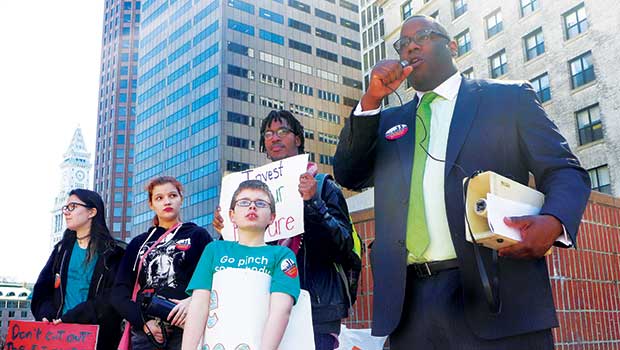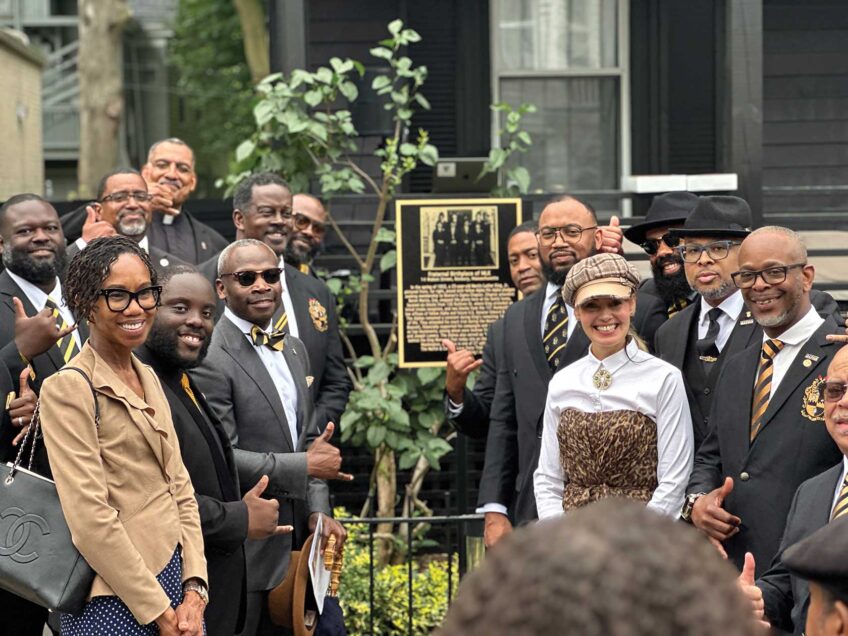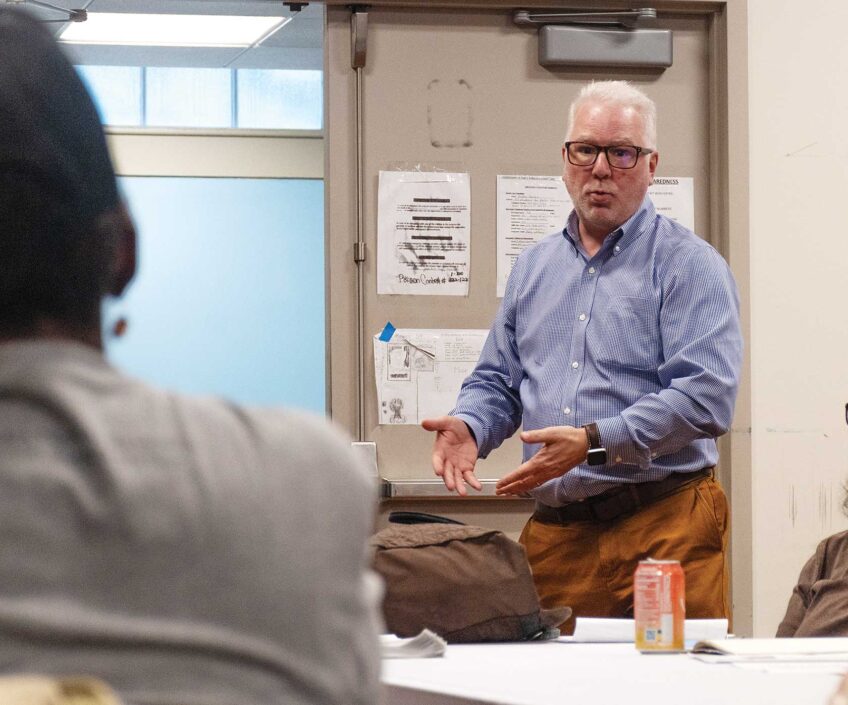Education is focal point in Boston mayoral race
Jackson, Walsh take different tacks on budgeting, closures

Education is emerging as a flash point in the 2017 mayoral race, with challenger Tito Jackson building on tensions over school funding, school closures and what some see as a lack of support for Boston’s district schools.

Author: Mayor’s Office photo by Don HarneyMayor Martin Walsh greets students at the Boston Public Schools for the 26th Annual Stay in School event at the Reggie Lewis Center earlier this year.
Over the last year, Jackson rose to prominence as a Boston spokesperson for the campaign against Ballot Question 2, an initiative that would have raised the cap on charter school expansion in Massachusetts. When students protested cuts to the BPS budget last year, staging a series of walk-outs and protests that drew thousands, Jackson was a vocal proponent of increasing funding. Such advocacy earned him a Massachusetts Teachers Association Friend of Education Award in May 2017.
Facing an uphill battle in his bid to unseat incumbent Mayor Martin Walsh, Jackson seems poised to turn up the heat. At a June 30 BPS Parents for Tito Jackson event, dozens of parents turned out in support of the District 7 City Councilor.
“What I really like about Tito Jackson is as chair of the [Boston City Council] Education Committee, he consistently advocated for resources for children of public schools,” said Mary Lewis-Pierce, who attended the fundraiser. Lewis-Pierce’s son is a rising sixth grader at the Hennigan, and her daughter a rising second grader at the Boston Teachers Union pilot school.
Lewis-Pierce said Jackson understands the social and emotional supports and services city children need, spotlights underfunding — such as high schools struggling to afford sufficient librarians, nurses and counselors — and has a strong track record of showing up for school committee votes and advocating at the State House.
In the other camp is Walsh supporter Chris Thompson, whose son attends grade 6 at the Joseph Lee K-8 and has an autism spectrum disorder. Thompson told the Banner he feels his son is well-served and that it now is easier to get help. He said Walsh stands out for a high level of involvement with youth and youth programs.
“I think Mayor Walsh would do an immaculate job,” Thompson said. “When I first started off, I couldn’t get my son into programs and it was difficult finding help.”
Budget battle
The 2016 walk-outs were in protest of a funding shortfall that demonstrators said would have caused losses to classes, teachers, extracurricular activities or, in some cases, entire programs. Teachers spoke of the cumulative effect of what they said was years of underfunding. Walsh revised the budget, producing one that instead decreased the funding schools receive to serve children with autism spectrum disorders and emotional needs. As a result, class sizes increased by about one student. This year, the proposed budget provides lower levels of direct funding to about 49 schools due to their smaller enrollments. In June, Jackson was the only city councilor to vote against this budget, charging it fails to adequately support schools.
Jackson maintained for both budget years that higher funding was possible. He previously said that millions designated in 2016 to repair the North Avenue Bridge as part of an enticement to General Electric should have gone to schools instead. In a recent Banner phone interview, Jackson said he again believed the school budget could be increased without harming other departments. He said better education support would generate savings by lowering instances of dropping out — which correlate with lower earnings, lower civic engagement and greater likelihood of incarceration — and decreasing public safety issues.
“In a Jackson administration, education as a priority means that other parts of the budget will actually be helped, not hurt, by increases in education. We are seeing an increase in shootings in the city right now. Increases to education and funding for youth programming are things that actually help reduce the burden on the public safety budget,” Jackson said. “You either pay now or you pay later.”
Walsh argues that schools are more than adequately funded, and that rising costs must be reined in. During an interview with the Banner at City Hall, Walsh said that changes to funding for autistic students and those with emotional impairments have not pushed class sizes above state recommendations, did not impact individual education plan funding (which is centrally budgeted) and was paired with other special education investments.
His office notes that BPS spends 45 percent more per pupil than districts regarded as comparable, although the data did not include information on the academic performance of those districts.
School needs and extras
When asked during the Banner interview if all schools should be guaranteed a nurse, librarian and/or arts and music programming — things Jackson has called for — Walsh said that in an ideal world, such provisions would happen. But in a world with limited money, Walsh said, it is not his place to tell principals how to spend the budgets they receive. He said that some schools may elect to have teachers double as librarians or to bypass certain non-core curriculum offerings in order to focus or specialize in other programming— for instance, STEM or arts.
“We can’t paint it with a broad brush and say every school should have this or that,” Walsh said. “School leaders make decisions and what happens is, political people say, ‘The mayor cut the budget. The school department cut the budget.’ … I shouldn’t be telling the principal how to spend the money in their school.”
Nurses, however, are budgeted centrally, and thus BPS administration, not school principals, determine their staffing.
Additionally, some educators say their school ought to receive budgets that can fund all the offerings they deem important to a quality education, instead of forcing principals to pick which important programs to keep.
Walsh’s administration has focused on expanding extended learning time and the Excellence For All program, which prepares students for exam schools. Jackson calls for instituting free bus passes for all students so transit expense is never a reason for absenteeism and for extending computer science classes to all grades K-12.
Both candidates said they want to expand and bolster vocational technical education, including by increasing private partnerships with Madison Park Technical Vocational High School. Walsh’s office said one-time city and state investments to Madison Park have improved the facility — including renovation of the welding shop — and a state grant underwrote a culinary arts program. Jackson said he wants more facility upgrades; an on-site bank, hair salon and car repair facility; and adult workforce training offered in the evenings.
Jackson and Walsh both advocate for expanded access to quality pre-kindergarten seats, with Jackson saying Walsh’s progress on this is too slow.
Staff diversity
According to BPS statistics, 86 percent of students identify as black, Latino or Asian, while 37 percent of the teaching staff is of color. Walsh says his administration has been working hard to increase the proportion of educators of color, while Jackson says efforts do not go far enough and that the previous administration made greater strides.
Jackson said he would bring deeper data gathering and analysis of recruitment and retention numbers, as well as aggressive, country-wide recruitment of teachers of color and those who are bilingual, in order to attain educators with backgrounds not readily found in local masters’ degree programs.
The Walsh administration’s efforts include a shift to hire staff earlier in the year, as well as talent development programs to train high school students and community members for teaching jobs. These include a nine-month training program for “racially, culturally and linguistically diverse” local residents or BPS paraprofessionals and substitutes in order to become novice teachers, and a separate training program for diverse community members seeking to become paraprofessionals. Jackson said a program to train paraprofessionals to become full-time teachers would be useful.
The Walsh administration’s nine-month teacher training program graduated 95 people over three years, of whom 49 percent have received placement. The paraprofessional program graduated 35 people over two years, of whom 48 percent received assignments. A seven-year program for BPS high school students in 2016 included 38 students, of whom 50 percent were black and 42 percent Latino. Other programs are aimed at networking or training current teachers for advancement.
Such efforts seem to be having an impact: According to the Walsh administration, people of color were hired disproportionately often in 2015-2016, with black candidates comprising 10 percent of applicants and 18 percent of new hires, and Hispanic candidates occupying 6 percent of the applicant pool yet 11 percent of new hires. Black BPS teachers are 30 percent less likely to voluntarily resign than white teachers, according to information provided by Walsh’s office. This year, 40 percent of BPS principals are black, 11 percent Hispanic, 1 percent Asian and 47 percent white.
Unified enrollment, charters and school closings
The William Rogers Middle School, Elihu Greenwood Leadership Academy, and the Mattahunt Elementary School closed during Walsh’s time in office. Jackson said these closures should have been avoided, while Walsh said they were non-ideal yet necessary reactions to the Rogers’ severe under-enrollment and the Greenwood and Mattahunt’s failing and near-failing statuses.
Further school closings are on the table — Walsh says he is looking to redesign and update schools, which could mean discontinuing use of facilities that prove too old for cost-effective renovation or that are unable to be expanded to provide space for programs such as science labs. Jackson also voiced support for facility upgrades and said Walsh has been too slow in enacting his BuildBPS 10-year facilities master planning process, which launched in 2015 and released its plan this year.
Jackson also said people should not forget the now largely-discredited McKinsey report commissioned by BPS in 2016, which suggested the district save money by closing 30 to 50 school buildings deemed “under-enrolled” based on a calculation that appeared to presume hallway and other non-classroom space could seat children, and disregarded teacher-student ratio standards. Some parents feared it was part of a plan to close district schools and convert them to charter schools.
Both Walsh and Jackson opposed passage of state ballot Question 2, which would have lifted the cap on charter schools.
Jackson continues to oppose the Boston Compact’s proposed unified enrollment system under which parents would apply to BPS and charter schools through the same process. He called the Compact “a secretive, not transparent organization that is also made of people who seek to compete with the Boston Public Schools,” and said that BPS should focus on its own schools. Meanwhile, Walsh said unified enrollment would level the playing field by providing all parents with an easy opportunity to apply to both such schools.
Walsh noted to the Banner that politicians in general ought not to politicize education decisions, while Jackson continues to hammer home that Walsh’s handling of education is one of his key criticisms.
“Politicians using schools as a political tool is unfortunate,” Walsh said. “Don’t use the kids as a political ploy.”
“Walsh has continued to turn his back on the students and parents in Boston Public Schools,” Jackson said.






